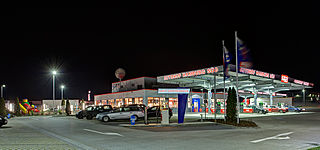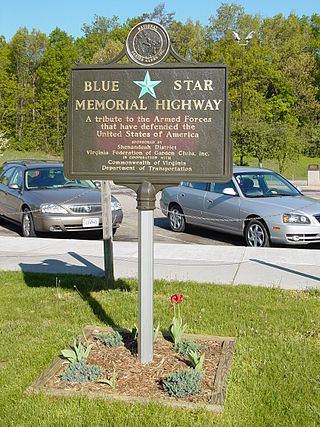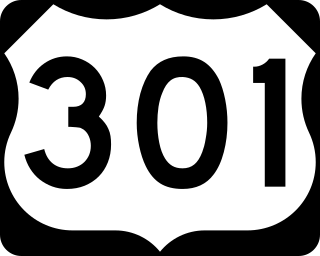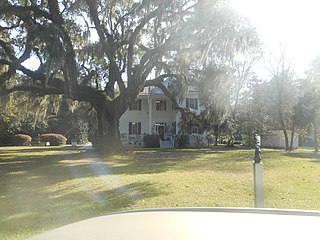
A motel, also known as a motor hotel, motor inn or motor lodge, is a hotel designed for motorists, usually having each room entered directly from the parking area for motor vehicles rather than through a central lobby. Entering dictionaries after World War II, the word motel, coined as a portmanteau of "motor hotel", originates from the Milestone Mo-Tel of San Luis Obispo, California, which was built in 1925. The term referred to a type of hotel consisting of a single building of connected rooms whose doors faced a parking lot and in some circumstances, a common area or a series of small cabins with common parking. Motels are often individually owned, though motel chains do exist.

Interstate 95 (I-95) is the main north–south Interstate Highway on the East Coast of the United States, running from U.S. Route 1 (US 1) in Miami, Florida, north to the Houlton–Woodstock Border Crossing between Maine and the Canadian province of New Brunswick. The highway largely parallels the Atlantic coast and US 1, except for the portion between Savannah, Georgia, and Washington, D.C., and the portion between Portland and Houlton in Maine, both of which follow a more direct inland route.

A rest area is a public facility located next to a large thoroughfare such as a motorway, expressway, or highway, at which drivers and passengers can rest, eat, or refuel without exiting onto secondary roads. Other names include motorway service area (UK), services (UK), travel plaza, rest stop, oasis (US), service area, rest and service area (RSA), resto, service plaza, lay-by, and service centre (Canada). Facilities may include park-like areas, fuel stations, public toilets, water fountains, restaurants, and dump and fill stations for caravans / motorhomes.

Wall Drug Store, often called simply Wall Drug, is a roadside attraction and tourist stop located in the town of Wall, South Dakota, adjacent to Badlands National Park. Wall Drug consists of a collection of cowboy-themed stores, including a drug store, gift shop, several restaurants, and various other stores, as well as an art gallery and an 80-foot brontosaurus sculpture. Unlike a traditional shopping mall, all the stores at Wall Drug operate under a single entity rather than being run individually. The New York Times has described Wall Drug as "a sprawling tourist attraction of international renown [that] draws some two million annual visitors to a remote town."

Blue Star Memorial Highways are highways in the United States that are marked to pay tribute to the U.S. armed forces. The National Council of State Garden Clubs, now known as National Garden Clubs, Inc., started the program in 1945 after World War II. The blue star was used on service flags to denote a service member fighting in the war. The program has since been expanded to include Memorial Markers and Memorial By-ways. These markers are used in National Cemeteries, parks, veterans facilities, and gardens.

U.S. Route 301 (US 301) is a spur of U.S. Route 1 running through the South Atlantic States. It runs 1,099 miles (1,769 km) from Biddles Corner, Delaware, at Delaware Route 1 to Sarasota, Florida, at U.S. Route 41. It passes through the states of Delaware, Maryland, Virginia, North Carolina, South Carolina, Georgia, and Florida. It goes through the cities of Middletown, Delaware; Annapolis, Maryland; Richmond and Petersburg, Virginia; Rocky Mount, Wilson, and Fayetteville, North Carolina; Florence, South Carolina; Statesboro and Jesup, Georgia; and Ocala, Zephyrhills, and Sarasota, Florida.
The Richmond–Petersburg Turnpike was a toll road located in the Richmond-Petersburg region of central Virginia, United States.

A roadside attraction is a feature along the side of a road meant to attract tourists. In general, these are places one might stop on the way to somewhere, rather than being a destination. They are frequently advertised with billboards. The modern tourist-oriented highway attraction originated as a U.S. and Canadian phenomenon in the 1940s to 1960s, and subsequently caught on in Australia.

Breezewood is an unincorporated town in East Providence Township, Bedford County in south-central Pennsylvania, United States.

The Big Pineapple is a heritage-listed tourist attraction at Nambour Connection Road, Woombye, Sunshine Coast Region, Queensland, Australia. It was designed by Peddle Thorp and Harvey, Paul Luff, and Gary Smallcombe and Associates. It is also known as Sunshine Plantation. It was added to the Queensland Heritage Register on 6 March 2009.

South of the Border is an attraction on Interstate 95 (I-95), US Highway 301 (US 301) and US 501 in Hamer, South Carolina, just south of Rowland, North Carolina. It is so named because it is just south of the border between North Carolina and South Carolina, and was the halfway point to Florida from New York in the early days of motor travel. The area is themed in faux-Mexican style, alluding to Mexico's location south of its border with the United States. The rest area contains restaurants, gas stations, a video arcade, motel, truck stop, a small amusement park, a mini golf course, shopping, fireworks stores, and a motocross training complex. Its mascot is Pedro, a caricature of a Mexican bandido. South of the Border is known for its roadside billboard advertisements, which begin many miles away from and incorporate a mileage countdown to the attraction itself. The stop has since fallen on hard times as more modern hotel areas have grown along I-95.

Interstate 95 (I-95) runs 179 miles (288 km) within the commonwealth of Virginia between its borders with North Carolina and Maryland. I-95 meets the northern terminus of I-85 in Petersburg and is concurrent with I-64 for three miles (4.8 km) in Richmond. Although I-95 was originally planned as a highway through Washington, D.C., it was rerouted along the eastern portion of the Capital Beltway concurrent with I-495. From Petersburg to Richmond, I-95 utilized most of the Richmond–Petersburg Turnpike, a former toll road. In addition to Richmond, the route also runs through the medium-sized cities of Emporia, Petersburg, Colonial Heights, Fredericksburg, and Alexandria.

Interstate 95 (I-95) is a part of the Interstate Highway System that runs along the East Coast of the United States from Miami, Florida, to the Canada–United States border at Houlton, Maine. In the state of North Carolina, the route runs for 181.36 miles (291.87 km) from the South Carolina border near Rowland to the Virginia border near Pleasant Hill. The highway serves the cities of Lumberton, Fayetteville, Wilson, Rocky Mount, and Roanoke Rapids. The route goes through a mostly rural area of the state, avoiding most of the major metro areas of North Carolina. It forms the informal border between the Piedmont and Atlantic Plain regions of the state.

Interstate 95 (I-95) is a major Interstate Highway, running along the East Coast of the United States from Florida to Maine. In South Carolina, I-95 runs approximately parallel to the Atlantic Ocean shore although about 50 miles (80 km) inland, from Hardeeville in the south to Dillon in the northeast. The route runs through the cities of Florence and Walterboro.

North Carolina Highway 46 (NC 46) is a primary state highway in the U.S. state of North Carolina; it is entirely in Northampton County. The route primarily connects the communities on the north side of Roanoke Rapids Lake and Lake Gaston, as well as the north side of the Roanoke River in the county.

North Carolina Highway 48 (NC 48) is a primary state highway in the U.S. state of North Carolina that principally connects the cities of Rocky Mount and Roanoke Rapids. The route offers an alternative to US 301 and I-95.

U.S. Route 301 (US 301) is a 189.704-mile (305.299 km) U.S. Highway that travels north–south from the Savannah River southwest of Allendale to Hamer approaching the South of the Border roadside attraction complex.

U.S. Route 301 (US 301) is a north–south United States highway that runs for 194 miles (312 km) in North Carolina from the South Carolina state line near Rowland to the Virginia state line near Pleasant Hill. The entire route parallels I-95. From the southern border to Hope Mills, it runs very close to I-95, crossing it several times and having a short concurrency with the freeway in Lumberton. From Hope Mills to Eastover, North Carolina it follows Interstate 95 Business, a partial freeway that passes through the center of Fayetteville. Passing through towns such as Dunn, Benson, Smithfield, and Selma that are bypassed by I-95, numerous local businesses targeted at I-95 travellers line this stretch, rarely does it veer more than a fraction of a mile from I-95. At Kenly, it leaves its close parallel of I-95, taking a route approximately 5 miles east of I-95 and passing through the center of the cities of Wilson and Rocky Mount. North of Rocky Mount it passes through several small towns, including Whitakers, Enfield, Halifax, and Weldon before passing into Virginia near Pleasant Hill. Through Rocky Mount the route divides into a Business and Bypass route, and there is also a short business loop in Halifax.

Point South is an unincorporated community located in Jasper County, South Carolina, United States near the borders of Beaufort and Hampton counties and close to the geographic center of the Lowcountry. It is centered on the junction of Interstate 95 and U.S. Route 17. It was developed partially by the Sea Pines Company in the 1960s and 1970s to help attract visitors to the Hilton Head region.

66 Motel, an independently owned six-room motel established 1946–47 in Needles, California, formerly served travelers on U.S. Route 66 in California. Bypassed circa 1970 by Interstate 40, the motel has been used as single room occupancy apartments since the 1990s.

















